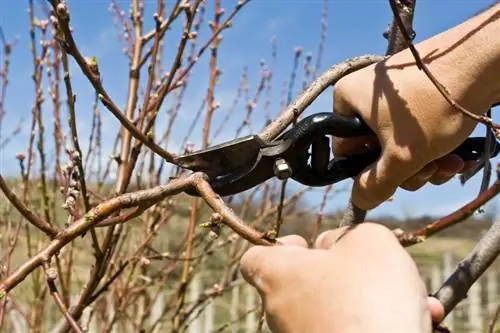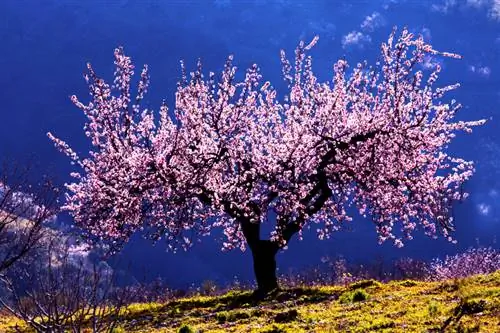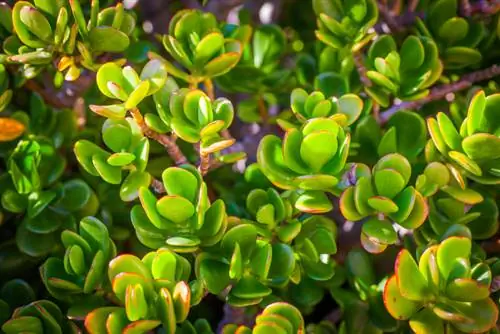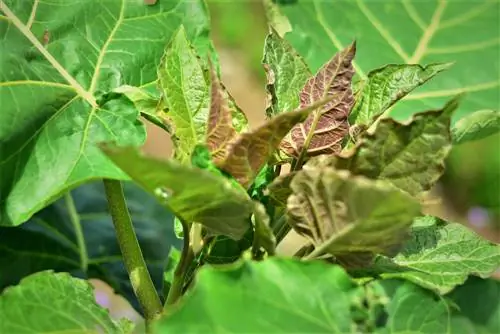- Author admin [email protected].
- Public 2023-12-16 16:46.
- Last modified 2025-06-01 06:02.
The bar for expert pruning care on the peach tree is higher than for domestic fruit trees. To ensure that the Asian fruit tree thrives, it is pruned vigorously every spring. The perfect cut requires a trained eye. It is important to distinguish between true and false fruit shoots. You can read everything you need to know about the perfect cut on the peach tree in this tutorial.
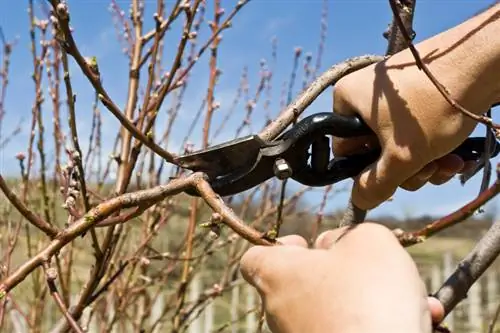
How and when do I prune a peach tree?
To prune a peach tree correctly, you should cut back wood shoots to 2 eyes, remove or shorten worn shoots and trim false fruit shoots to short cones. The best time for maintenance pruning is in February or after the harvest.
Prune short-lived fruit wood annually
The most productive fruit wood on the peach tree is onannual long shoots As with local sour cherries, these grew to a length of 20 to 40 centimeters last year. A long shoot only produces juicy peaches once in its life. From the third year onwards, the wood no longer has any flower buds to offer and becomes noticeably bald. You will only harvest delicious fruit from an uncut peach tree for a few years. By rotating the scissors every year, the fruit tree will remain fruitful and vital for many years.
Best time is in spring
For a masterful cut, it is essential to clearly identify flower and leaf buds. For beginners in pruning peach trees, we recommend February as the best time for maintenance pruning, shortly before the flowering period begins. During this phase, rounded flower buds can be clearly identified, even to the untrained eye. Anyone who misses the deadline cuts immediately after the harvest. In both cases, the risk of valuable fruit wood falling victim to the scissors is minimal.
As long as a peach tree is in the training and development phase, early spring makes sense as a pruning date. Pruning at the end of winter stimulates growth, which is desirable for the rather weakly growing tree.
Background
Prune trees from October 1st to March 1st - for the benefit of our bird life
If you cut your peach tree in spring or autumn, you are making an important contribution to nature conservation. Thebreeding seasonof our massively threatened bird world extends from the beginning of March to the end of September. In the fight against the “silent spring”, the Federal Nature Conservation Act emphasizes the fundamentally importantgrace period with paragraph 39. This stipulates that tree pruning is fundamentally prohibited. If it has been ruled out in advance that there are wild animals overwintering in the treetop or hedge, cutting may be carried out between October 1st and March 1st.
Sensible cuts
Scissors are a constant companion when caring for peach trees. On the day of planting, continuous pruning begins, which continues with a training pruning for the first three to four years and culminates in an annual maintenance pruning. The following table summarizes all sensible types of pruning for a richly bearing peach tree:
| Cut style | Goal/Occasion | best date | Alternative date |
|---|---|---|---|
| Plant cutting | stimulating vital branching, initiating education | in spring after planting | none |
| Educational Cut | build a productive crown | February | none |
| Conservation cut | promote young fruit wood, regulate growth, thin out | February | Early to mid October |
The table does not list a rejuvenation cut for good reason. Peaches and nectarines do not tolerate larger cuts. If the size of a wound exceeds the diameter of a 2 euro coin, a massive flow of rubber begins, from which the Asian fruit tree usually no longer recovers.
Distinguish between true and false fruit shoots
The fine art of cutting peaches and nectarines is distinguishing between true and false fruit shoots. That sounds more complicated than it actually is. We invite you to take a short excursion into basic botanical knowledge in order to understand the connections and implement them when pruning peaches. The illustration below illustrates that four different types of shoots can form on the framework shoots of a peach crown. The following overview summarizes all important identifying features:
Wood shoot (1)
Wooden shoots are characterized bypointed shoot buds These shoots are also known as sterile branches because they neither flower nor fruit. If a wood shoot does not contribute to crown development during the training phase, it is shortened significantly. By leaving one or two buds standing, you protect the chance that a valuable fruit shoot will grow here next year.
False fruit shoot (2)
You can identify a false fruit shoot by the numerous rounded flower buds from the base to the end. There is only a pointed leaf bud at the tip of the shoot. Pseudo-fruit shoots represent the greatest pruning challenge for home gardeners. The many flowers are initially misleading because they develop picturesquely and even form small fruits. However, there are no leaves for an adequate supply of nutrients. Sooner or later, flowers and fruits fall off due to a lack of energy supply. However, false fruit shoots cannot be completely removed. As long as a small residue remains with sleeping eyes, it can still develop into a true fruit shoot.
True Fruit Shoot (3)
On the true fruit shoot, all is well with the world. A combination of rounded flower buds and pointed leaf buds thrive at each bud base. The arrangement in which the buds sprout can vary. It is important for fertility that there is a leaf bud in the immediate vicinity of the flower bud as a source of supply. A true fruit shoot often ends with leaf buds at the base or tip, which does not contradict its fertility.
Bouquet shoot (4)
Valuable fruit wood includes all short shoots that are richly decorated with thick flower buds and have a leaf bud at the top for nutrient supply. For this reason, bouquet shoots are also known as fruit skewers and are not cut.
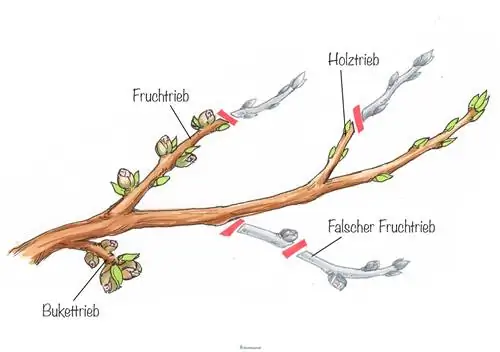
All types of shoots on the peach tree at a glance: Wooden shoot (1) only has pointed shoot buds - false fruit shoot (2) has flower buds along its entire length and a leaf bud at the end - true fruit shoot (3) has two round flower buds at each bud base, which flank a leaf bud - bouquet shoot (4) short fruit spear, richly garnished with flower buds and a pointed leaf bud.
Plant cutting instructions
Pruning has important tasks. It gets the branching going and initiates crown training. The best time to plant heat-loving trees such as peaches and nectarines is in spring. Immediately afterwards, give the tree a first cut. How to do it right:
- Choose the ideal crown framework from a dominant central shoot and 4 side scaffold shoots
- Remove remaining shoots
- Cut back side scaffold shoots by a third
- Important: Tip bud must be an outward-facing leaf bud
Please cut the middle shoot as a trunk extension so that its tip bud is about a scissor length above the tip buds of the leading branches. Their shoot tips are at approximately the same height, which in gardening terms is referred to as a sap scale. If a top bud is higher, the growth law of top support takes effect at this point. The result would be increased, one-sided growth, which runs counter to a harmonious crown shape and makes the entire peach tree unstable.
Training hollow-crowned peaches
Domestic fruit trees, such as apple and sweet cherry, thrive productively with a classic round crown. This does not apply to peaches and nectarines. To ensure that Asian fruit trees bloom and fruit lushly, thehollow crown has proven itself excellent in gardening practice. As the illustration below demonstrates, with this crown shape the dominant central shoot is cut back after three years so that more sunlight can reach the interior of the crown. How to proceed correctly step by step:
- The best time is in February, second to fourth year
- Up to the third year: Train the crown with a central shoot and 4 evenly distributed leading branches
- Extend the scaffolding by a maximum of 30 cm every year
- Remove the central shoot in February of the third or fourth year
The fertility ofleading branchesis optimized when they are aligned at an idealangle of 60° to the trunk. Branches that are too steep can be spread out using clothespins or spreading sticks. Tie up shoots that are too flat. When pruning, please make sure that the end buds of the leading shoots are at the same level, i.e. in thejuice scale. Branches sprouting from the trunk below the crown are removed.
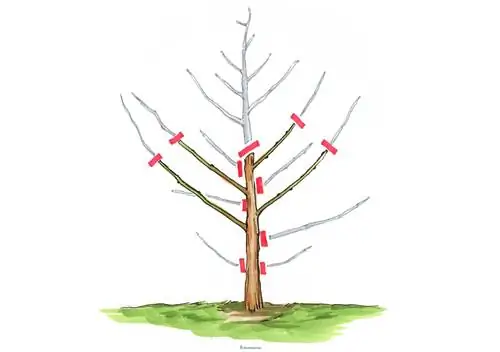
Train a peach tree with a hollow crown flooded with light. In the third year at the latest, the central shoot is removed so that sunlight reaches all four leading branches evenly.
Excursus
Pruning the peach tree after transplanting
Your peach tree will receive an out-of-order cut if you have transplanted it. The fruit tree survives a change of location well within the first five years of growth. The best time is in early spring, shortly before budding begins. Transplanting involves a massive loss of root mass for any tree. In addition to traditional maintenance pruning, cut the entire crown back by a third. Thanks to this measure, you can restore the balance between underground and above-ground plant parts.
Cutting instructions for beginners
When pruning peach trees, the transition from training to maintenance is fluid. Competent tree nurseries offer the trees as bush trees with a 60 centimeter short trunk and a total height of 150 centimeters. Without cutting, the trees reach a maximum height of 500 centimeters. The particular advantage is an early start to the yield phase in the second or third year. How to complete the perfect maintenance cut:
- Cut back wood shoots to 2 eyes so that - with a bit of luck - they can sprout fruit wood
- Remove three quarters of the removed shoots from the crown except for a short stub
- Remaining, worn shoots shorten to 3 buds from which new fruit shoots grow
- Cut back false fruit shoots to 2 cm short cones
The shoot tips of true fruit shoots are often covered with numerous leaf buds. You can cut off this part of the shoots. Furthermore, remove all unfavorable branches and twigs that do not contribute to the crown structure or fruit yield.
Tip
In peach trees with hollow crowns, annual long shoots may, as an exception, point inwards. In full sun they protect the inside of the crown from sunburn.
Frequently asked questions
Is a peach tree self-fertile?
Peach trees available from specialist retailers are generally self-fertile. For a harvest of juicy, sweet fruits, one specimen in the garden is enough. Nevertheless, it is advisable to combine two types of peaches in order to significantly increase the yield. When purchasing, ask your trusted tree nursery which variety constellation is best.
What root system does a peach tree grow with? We would like to plant it near a paved area
Peach trees grow as heartroots. A system of numerous, strong root strands spreads out in all directions. Please maintain a distance of at least 100 centimeters from paved areas. Otherwise there is a risk of horizontal roots lifting the pavement.
My dwarf peach tree in the pot bloomed magnificently this year. Unfortunately it bears no fruit. There are currently two thin branches sprouting from the bottom of the trunk. Can I just cut off these shoots?
You should definitely remove both shoots because they are so-called wild shoots or water shoots. Tear off each branch with a courageous tug. After a cut, plenty of cell tissue remains from which the wild shoots sprout happily. Your dwarf peach tree is probably a non-self-fruitful variety. In order for the flowers to turn into fruit, they must be pollinated. This requires both a pollinator species nearby and hard-working insects that transport the pollen from one peach to the next.
How much frost can a peach tree withstand?
A well-grown peach tree can withstand temperatures of up to -25 degrees Celsius. This applies provided that it is in a sunny, wind-protected location. When it is young, the tree still has to acquire winter hardiness. Light winter protection is advisable in the first and second year. Cover the tree disc with leaves and brushwood. If late frosts threaten, cover the crown with breathable fleece.
The 3 most common cutting mistakes
The special characteristics in the growth of peaches and nectarines lead home gardeners to make typical mistakes in pruning care. Fatal results are an impenetrable network of old and young branches or a richly flowering tree without fruit. So that you don't have to deal with such damage, the following table lists the three most common cutting errors and gives short tips for prevention:
| Cutting errors | malicious image | Prevention |
|---|---|---|
| never cut | dense tangle of old, sterile and bald branches | Prune the peach tree vigorously every year |
| sterile and false shoots not pruned | despite flowers, no or few fruits | Cut back wooden shoots and false fruit shoots to short cones |
| Education with a round crown | premature baldness inside the crown | Training hollow-crowned peaches |

Tip
Peach trees are part of the rose family. This property requires special attention when rotating crops. Never plant peach after peach. Gardening practice has shown that there is a risk of massive damage to young trees as a result of soil fatigue. A cultivation break of four to five years guarantees that the soil can recover to accommodate peach trees or other rose plants again.

